Python is a versatile programming language that offers libraries and tools for scientific computing and mathematical calculations.
Many essential mathematical operations frequently involve definite and indefinite integrals. In this article, we will explore how to perform these calculations using Python.
How to Calculate Single Variable Definite Integrals
Install SciPy
Before we start, we need to install the SciPy module. It provides a collection of Mathematical algorithms and functions that we'll use.
You can do this by running the following command in a terminal:
pip install scipyTo calculate single variable definite integrals, we need to first import quad from scipy.integrate. It is a general purpose function used to calculate single variable definite integrals.
from scipy.integrate import quadElementary Functions
From there, we'll need to define the integrand as a function in Python.
For example, if we wanted to calculate the integral of x-squared, we would define the integrand as a Python function like so:
def integrand(x):
return x**2Once we define the integrand, we can calculate the definite integral using the quad function like this:
print(quad(integrand, 0, 1))
# (0.33333333333333337, 3.700743415417189e-15)
In the above code, 0 represents the lower limit of integration and 1 represents the upper limit of integration. They can be any other number.
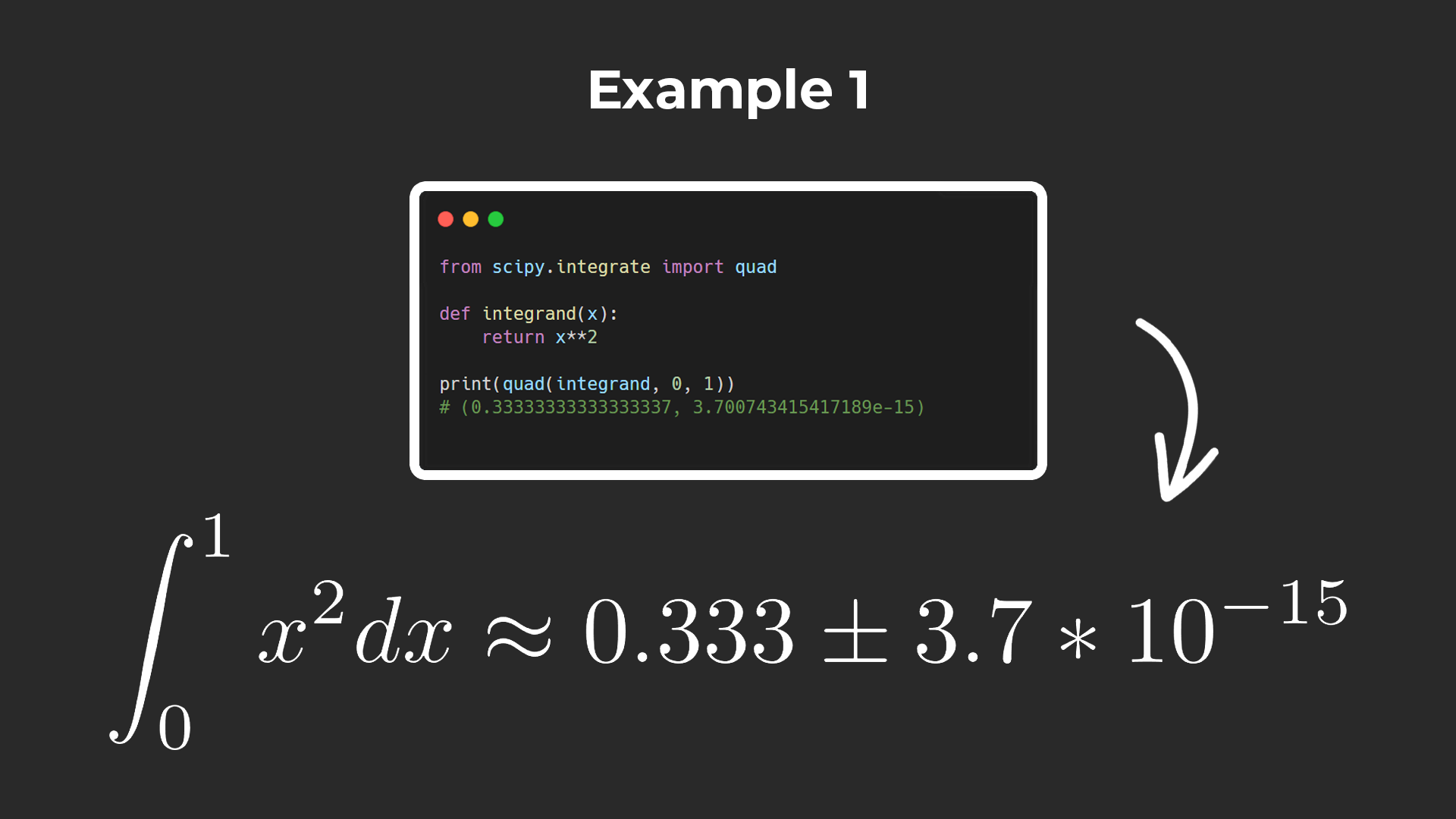
In this example, we calculate that the estimated result of the integral from 0 to 1 of x-squared is approximately 0.333 with an absolute error of roughly 3.7e-15.
The quad function returns a tuple of an estimation of the definite integral followed by the absolute error of the estimation.
What the quad function does is essentially evaluate the integrand function at multiple different values between our limits of integration to be able to calculate an estimate of the integral.
Another example would be if I wanted to calculate the integral of (x+1)/x**2. We would first define it as a function in Python, and pass it into the quad function along with the limits of integration:
from scipy.integrate import quad
def integrand(x):
return(x+1)/x**2
print(quad(integrand, 1, 2))
# (1.1931471805599452, 1.3246594716242401e-14)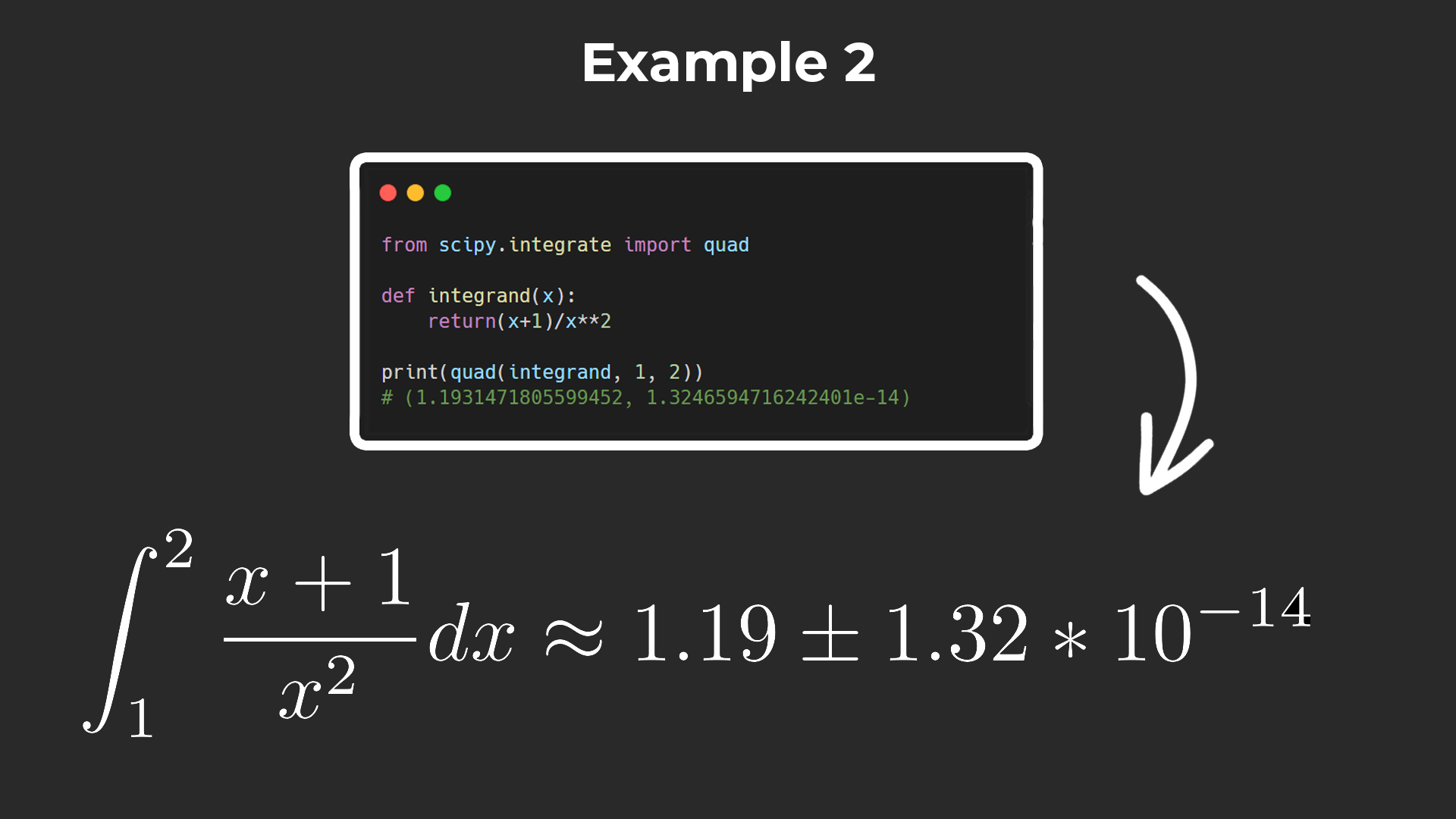
In this example, we calculate that the estimated result of the integral from 1 to 2 of x +1 all over x-squared is approximately 1.19 with an absolute error of roughly 1.32e-14.
Other Common Functions
If we wanted to use common mathematical functions such as sin(x) or log(x), we can use another Python package for scientific computing – NumPy. You can install the package using the following command:
pip install numpyBy importing it, we have access to these common functions which we can use in our integrand:
from scipy.integrate import quad
from numpy import log, sin
def integrand(x):
return log(sin(x))
print(quad(integrand, 0, 2))
# (-1.1022223889049558, 1.2237126744196256e-15)
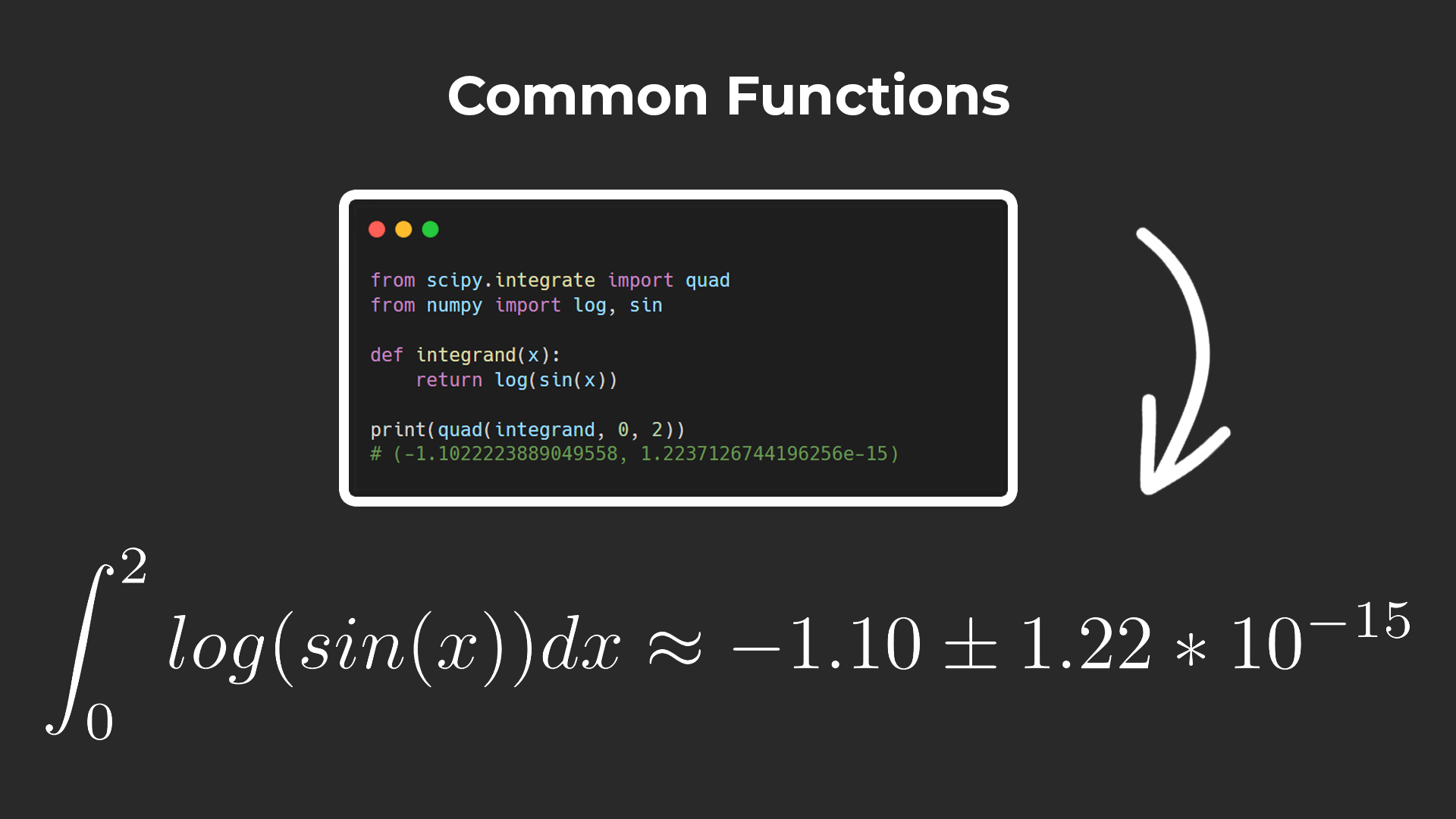
In this example, we calculate that the estimated result of the integral from 0 to 2 of log(sin(x)) is approximately -1.10 with an absolute error of roughly 1.22e-15.
A full list of mathematical functions that NumPy provides is in their documentation.
How to Use Constants
NumPy also provides useful constants such as e and pi, as well as inf. It's a floating point representation of positive infinity. We can use it to calculate a definite integral that converges.
from scipy.integrate import quad
from numpy import inf, exp
def integrand(x):
return exp(-x)
print(quad(integrand, 0, inf))
# (1.0000000000000002, 5.842606742906004e-11)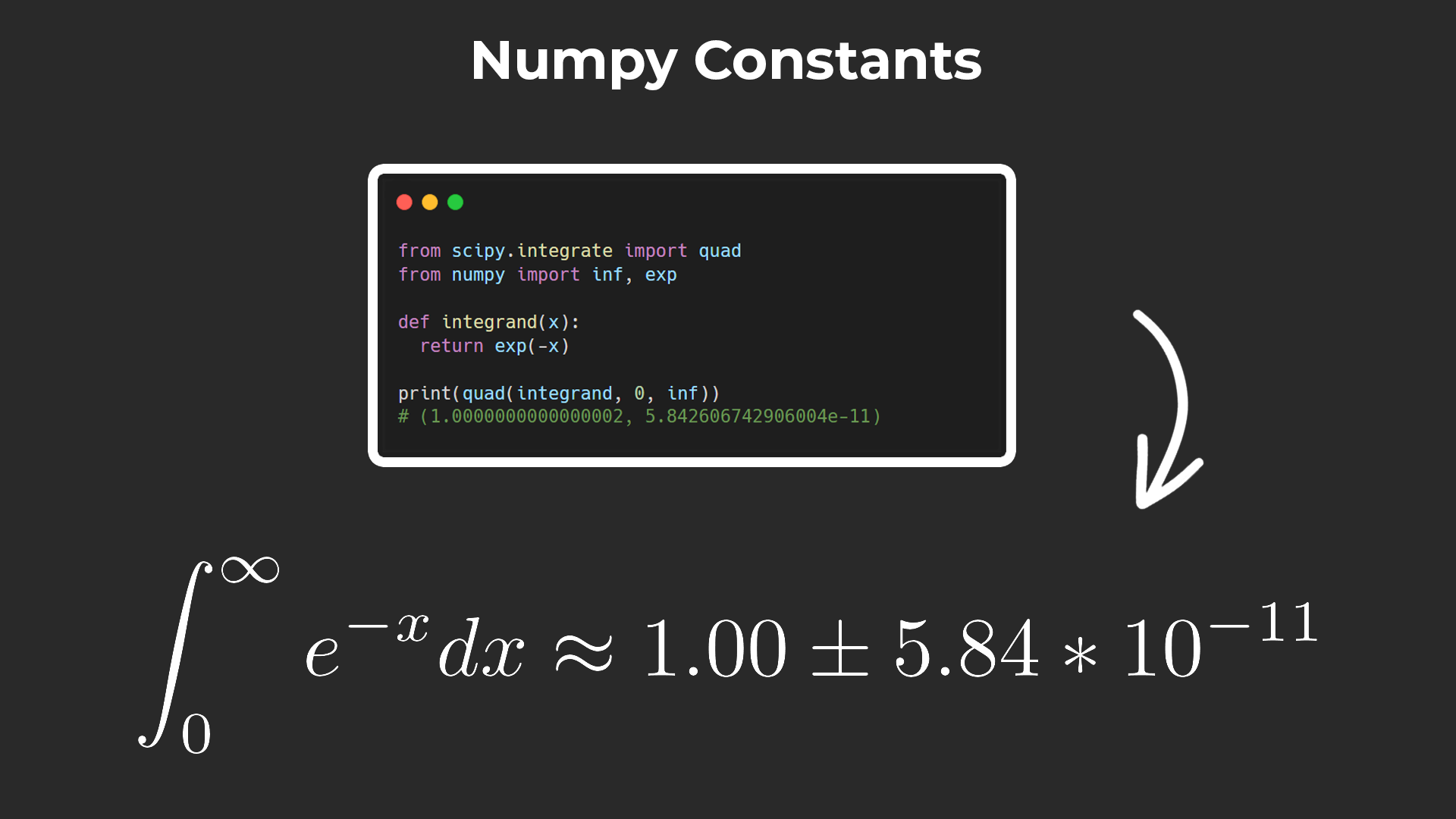
In this example, we calculate that the estimated result of the integral of e raised to the negative x from 0 to infinity is approximately 1.00 with an absolute error of roughly 5.84e-11.
How to Calculate Multi-Variable Integrals
Double Integrals
To calculate double integrals, we need to import the dblquad function from scipy.integrate:
from scipy.integrate import dblquadWe define the integrand in a similar way to definite it with one variable, only this time we specified two arguments instead.
def integrand(y, x):
return x*y**2We can then calculate the definite integral using the dblquad function given by scipy.
Note that the integrand is a function that needs to accept y as the first parameter and x as the second parameter.
print(dblquad(integrand, 0, 1, 2, 4))
# (9.333333333333334, 2.0679162295394134e-13)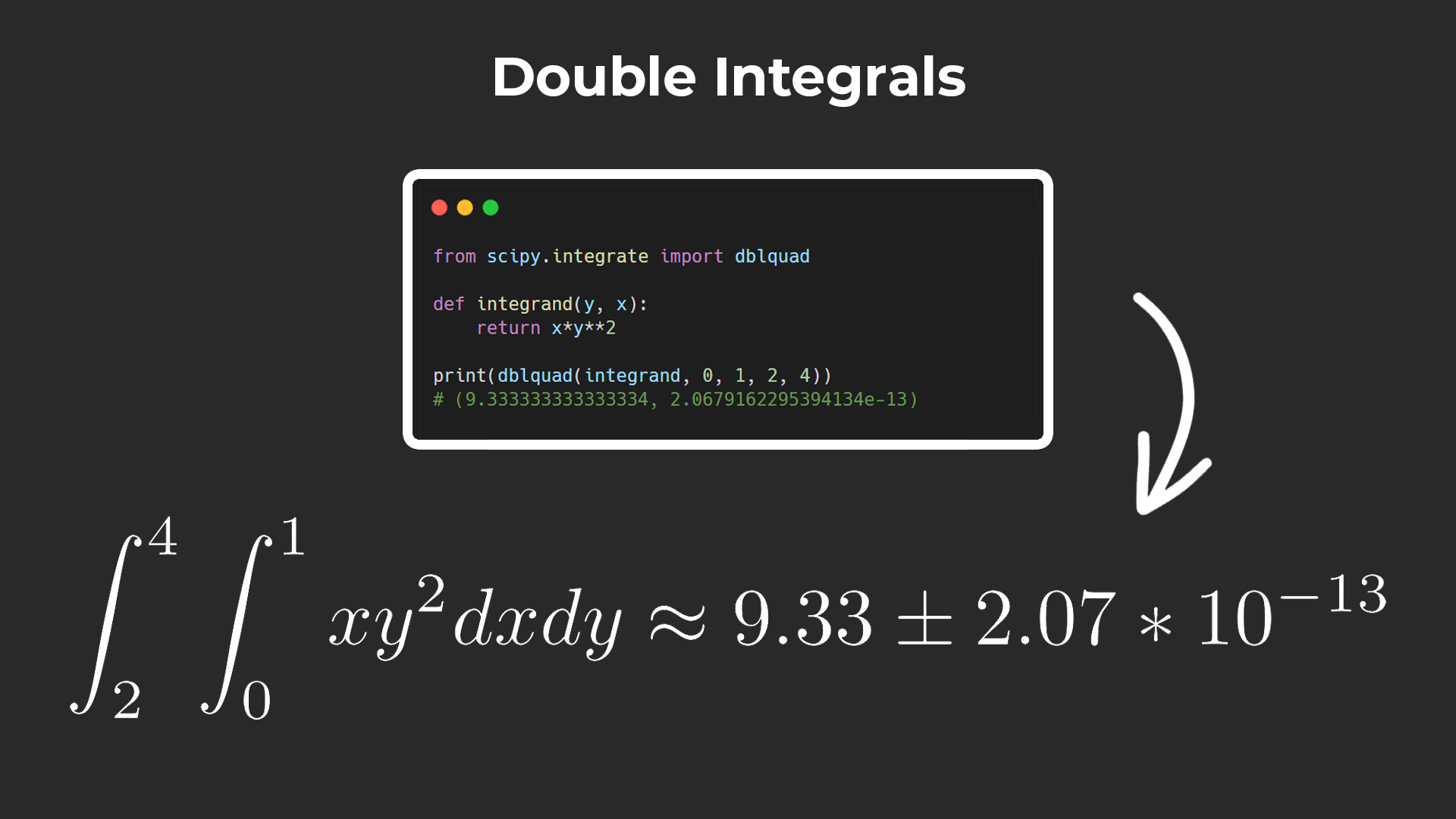
In this example, we calculate that the estimated result of the double integral x times y-squared from x = 0 to 1 and from y = 2 to y = 4 is approximately 9.33 with an absolute error of roughly 2.07e-13.
The function requires us to pass in the integrand, and the lower and upper limits of integration for x, followed by the lower and upper limits of integration for y.
Variable Limits
To calculate integrals with variable limits, we'll need to define functions for the lower and upper limits of integration for y in terms of x:
def upper_limit_y(x):
return x**2
def lower_limit_y(x):
return x
def integrand(y, x):
return x+y
print(dblquad(integrand, 0, 2, lower_limit_y, upper_limit_y))In this example, we calculate that the estimated result of the double integral of x+y from x = 0 to x = 2, and from y = x to y = x^2 is approximately 3.2 with an absolute error of roughly 1.10e-13.
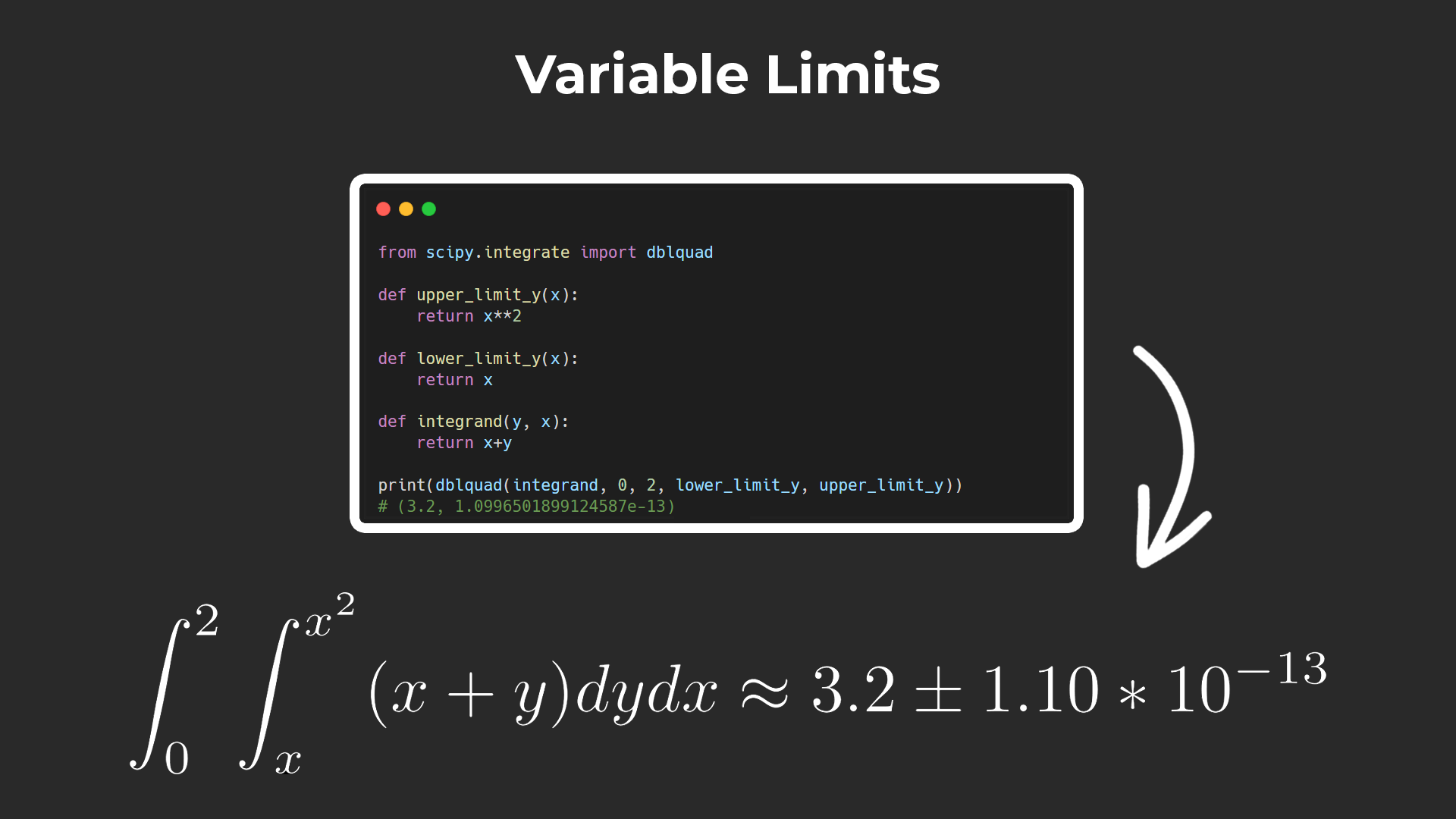
Triple Integrals
To calculate triple integrals, we can use the tplquad function:
from scipy.integrate import tplquad
def integrand(z, y, x):
return z*(x+y+z)
print(tplquad(integrand, 0, 1, 4, 5, 0, 1))
# (2.8333333333333335, 3.6983326566167174e-14)
The function requires us to pass in similar arguments, being the upper and lower limits of integration in x, y and z.
In this example, we calculate that the estimated result of the triple integral of z multiplied by (x+y+z) from x = 0 to x = 1, y = 4 to y = 5, and z = 0 to z = 1 is approximately 2.83 with an absolute error of 3.70e-14:
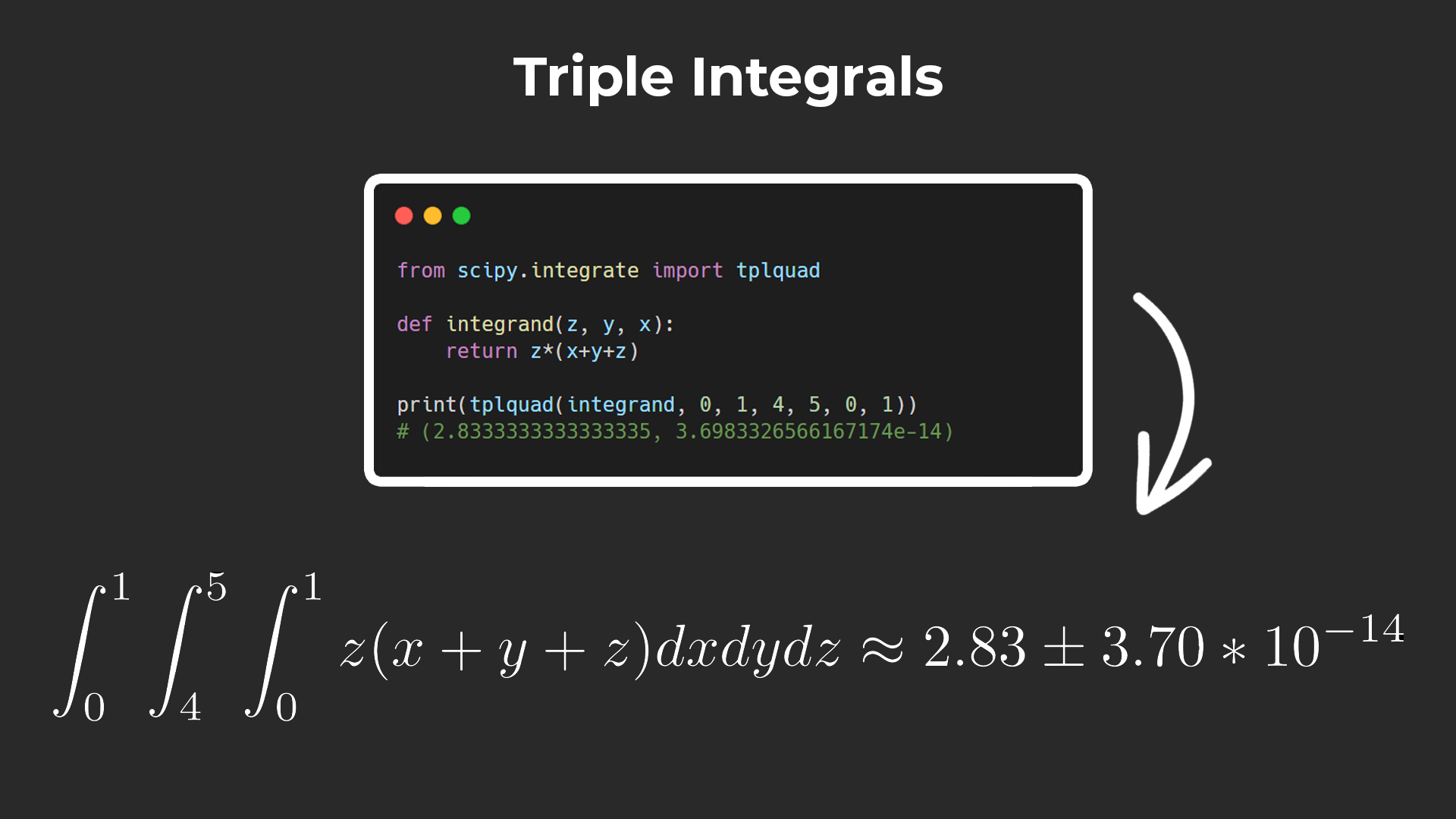
How to Evaluate Single Variable Indefinite Integrals
To calculate single variable indefinite integrals with Python, we need to use the SymPy library. It's used for symbolic computation and involves exact computation using variables. To install it, install the SymPy module:
pip install sympyOnce it has been installed, we can import the Symbol and integrate methods from sympy:
from sympy import Symbol, integrateWe first need to define the variables used in the integrand:
x = Symbol('x')
After that, we can integrate the function using the integrate method that SymPy provides. It expects two arguments: the first is the integrand, and the second is the variable we are integrating with respect to.
For example, if we wanted to integrate x-squared with respect to x, we can define the integrand in Python as x**2:
print(integrate(x**2, x))
# (x**3)/3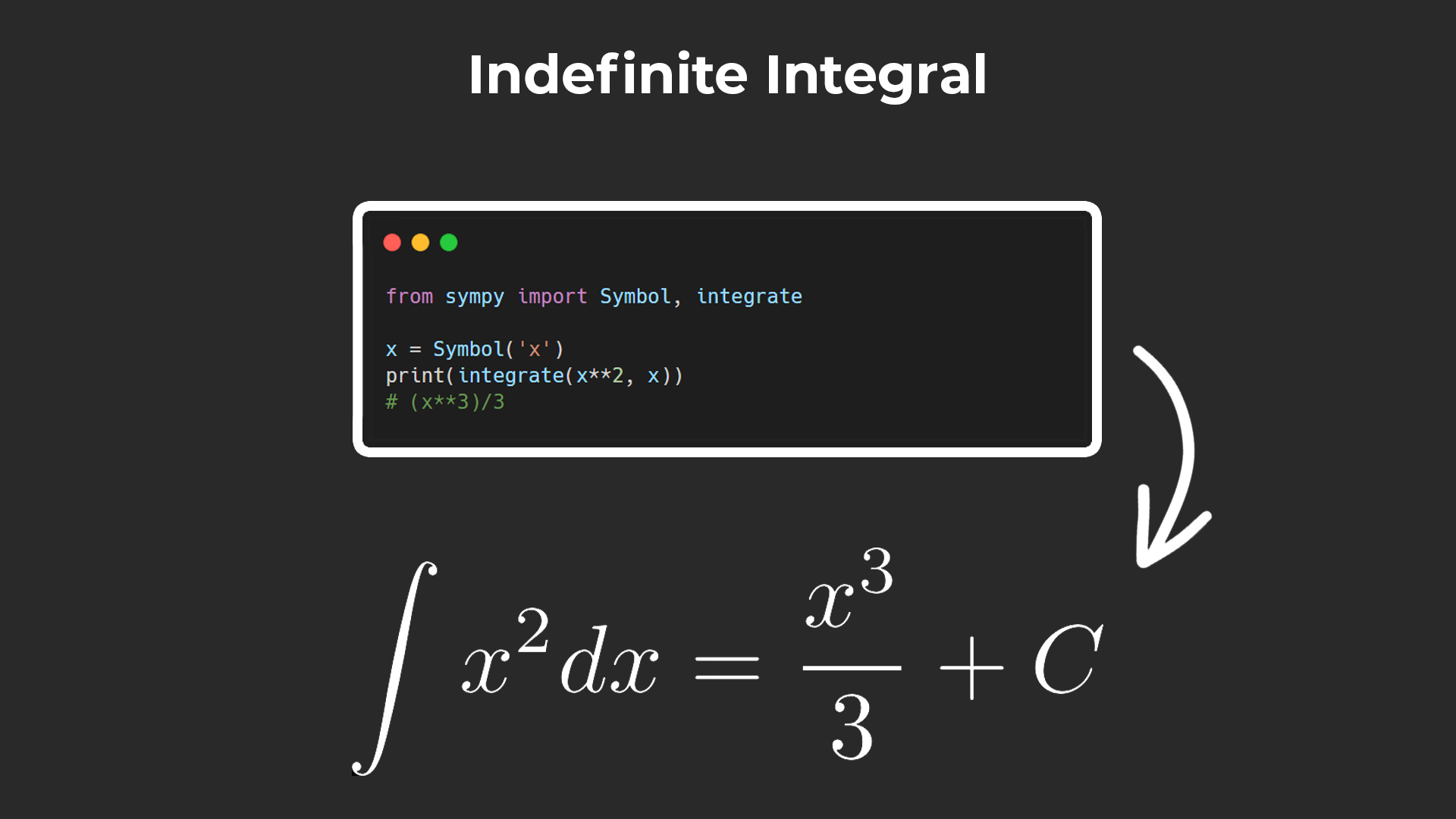
In this example, we calculate the integral of x-squared which is x-cubed over 3.
Note that SymPy doesn't add the constant of integration, but it is implied.
SymPy also provides other common functions such as sin(x) and exp(x) that we can use.
Before using them, we first need to import it from sympy:
from sympy import Symbol, integrate, sinUsing the imported sin function, we can then evaluate the integral of sin(x).
x = Symbol('x')
print(integrate(sin(x), x))
# -cos(x)In this example, we calculate the integral of sin(x) which is -cos(x):
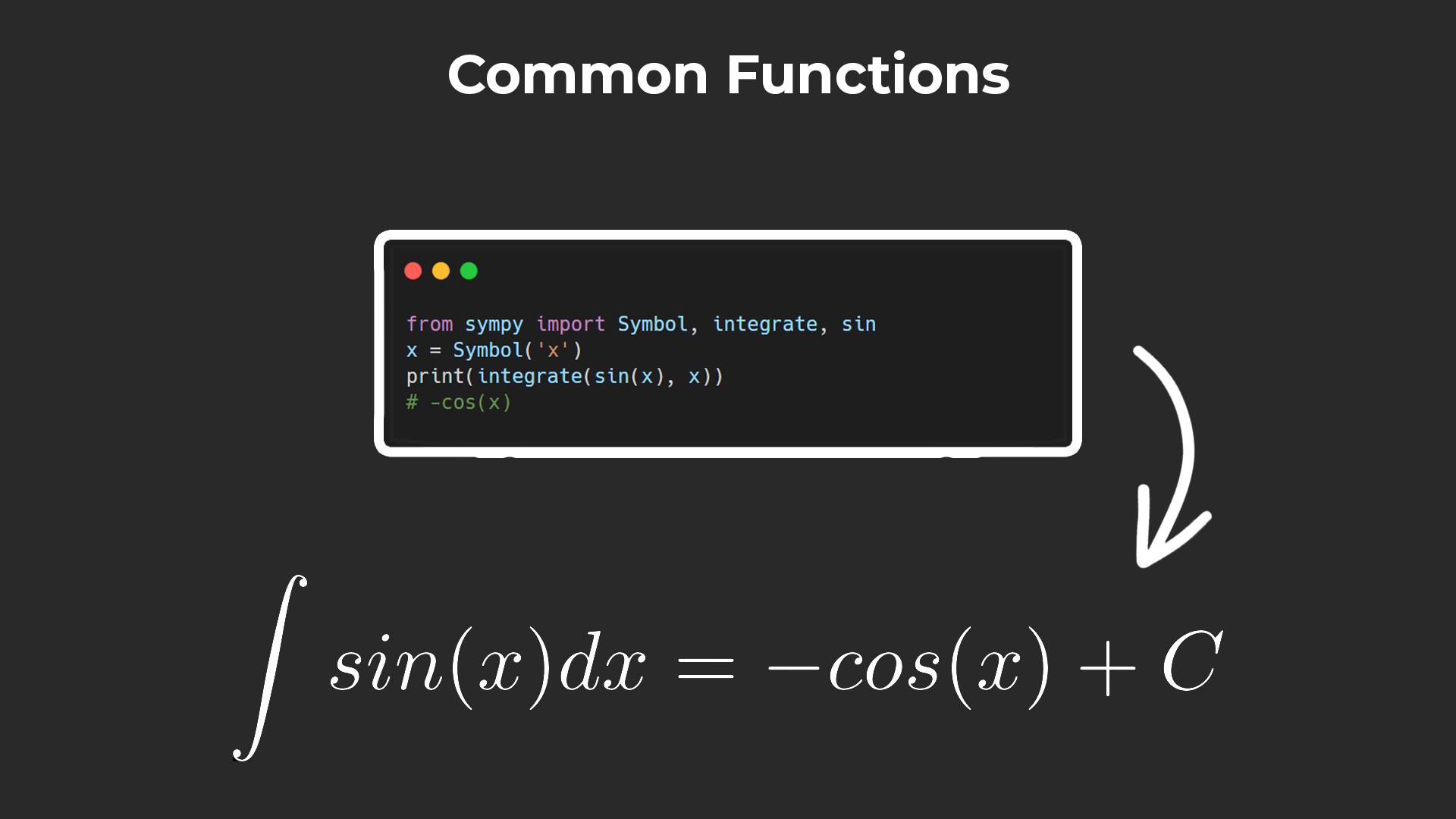
Sympy provides the full list of mathematical functions you can use in their documentation
Summary
In this tutorial, we went over the basics of how to calculate both definite and indefinite integrals in Python. We also looked at how to calculate integrals of elementary functions, ones that involved common mathematical functions, as well as using constants.
We made use of popular Python libraries for scientific comptutation and went over examples of calculating integrals.
If you enjoy my writing, consider subscribing to my YouTube channel.
Happy Coding!

